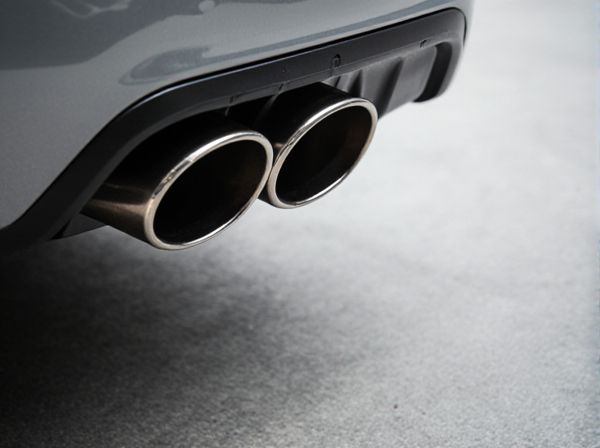
Photo illustration: Straight Pipe vs X-Pipe
Straight pipes increase exhaust flow and engine sound by providing a direct path, resulting in louder, more aggressive performance. X-pipes balance exhaust pulses between both sides, improving scavenging and promoting higher horsepower with a smoother, more refined tone. Choosing the right option depends on whether You prefer raw power and volume or enhanced efficiency and a balanced exhaust note.
Table of Comparison
| Feature | Straight Pipe | X-Pipe |
|---|---|---|
| Design | Simple, straight tubing from headers to muffler or tip | Cross-shaped connecting pipe between two exhaust pipes |
| Exhaust Flow | Unrestricted, direct flow | Balances exhaust pulses for smoother flow |
| Performance Impact | Increases horsepower by reducing backpressure | Improves mid-range torque and horsepower via pulse tuning |
| Sound | Loud, aggressive, raw exhaust note | Smoother, quieter, with a subtle growl |
| Emissions | Typically higher due to lack of catalytic converters | Can support emissions controls better than straight pipe |
| Best Use | Racing, off-road, or show cars | Street performance and daily driving |
Introduction to Exhaust Pipe Configurations
Straight pipes offer a direct, unrestricted exhaust flow that enhances horsepower and engine sound but may increase noise and emissions. X-pipes merge exhaust gases from opposite banks into a single crossover, promoting improved scavenging for smoother performance and balanced backpressure. Choosing between straight pipes and X-pipes depends on desired sound levels, performance gains, and emission considerations in exhaust system design.
Understanding Straight Pipe Systems
Straight pipe systems offer a direct exhaust flow with minimal restrictions, enhancing horsepower and torque by reducing backpressure. These systems are commonly used in performance vehicles seeking maximum exhaust velocity and a louder, more aggressive sound profile. Unlike x-pipes, straight pipes do not promote exhaust scavenging, which may affect the overall engine efficiency in certain setups.
What Is an X-Pipe?
An X-pipe is an exhaust component designed to merge the exhaust gases from dual pipes into a single crossing point, improving exhaust scavenging and boosting engine efficiency. Unlike a straight pipe that simply runs exhaust gas straight through without interference, the X-pipe balances exhaust pulses by allowing gases to flow smoothly between the two sides, reducing backpressure. This results in increased horsepower, improved fuel economy, and a smoother, higher-pitched exhaust tone favored in performance vehicles.
Sound Comparison: Straight Pipe vs X-Pipe
Straight pipes produce a loud, aggressive exhaust note with minimal sound restriction, emphasizing raw engine noise and deep, throaty tones. X-pipes balance performance and sound by promoting exhaust gas scavenging, resulting in a smoother, higher-pitched tone with reduced drone and enhanced RPM range clarity. Vehicle enthusiasts choose straight pipes for maximum volume and X-pipes for refined, balanced exhaust sound characteristics.
Performance Differences Explained
Straight pipes offer the least exhaust flow restriction, resulting in maximum horsepower gains and a louder exhaust note, ideal for high-performance engines that prioritize raw power. X-pipes optimize exhaust scavenging by balancing exhaust pulses between cylinder banks, improving mid-range torque and creating a smoother, more refined sound. Choosing between straight pipe and X-pipe configurations depends on whether peak horsepower or enhanced throttle response and sound quality are the primary goals.
Installation and Compatibility Factors
Straight pipes offer a simpler installation process due to their linear design, making them compatible with most exhaust systems without requiring modifications. X-pipes, designed to balance exhaust pulses, may require precise alignment and additional adjustments for proper fitment, especially in custom or aftermarket setups. Compatibility depends on vehicle model and exhaust configuration, with straight pipes favored for ease and X-pipes preferred for performance tuning and sound refinement.
Pros and Cons of Straight Pipe Systems
Straight pipe systems offer increased exhaust flow and reduced backpressure, enhancing engine performance and horsepower. They tend to produce a louder, more aggressive exhaust note, which may be undesirable in noise-restricted areas and can lead to legal issues due to emissions regulations. However, straight pipes lack the scavenging benefits of X-pipes, often resulting in lower torque at low RPMs and decreased fuel efficiency.
Advantages and Disadvantages of X-Pipes
X-pipes improve exhaust scavenging by balancing exhaust pulses, leading to enhanced horsepower and a smoother engine sound compared to straight pipes that provide a louder, more aggressive tone. They reduce exhaust drone, which enhances driving comfort during long trips, though they may slightly restrict flow in high-performance setups, potentially limiting maximum power gains. Choosing an X-pipe benefits vehicles aiming for balanced performance and refined acoustics, while straight pipes are favored for maximum loudness and minimal backpressure.
Best Applications for Each Exhaust Type
Straight pipes excel in high-performance applications where maximum exhaust flow and minimal backpressure are crucial, such as in drag racing or competitive street racing. X-pipes are best suited for muscle cars and performance street vehicles aiming to enhance exhaust scavenging, improve mid-range torque, and achieve a balanced sound. Choosing between straight pipe and X-pipe depends on the desired balance of power delivery, sound characteristics, and vehicle usage.
Choosing Between Straight Pipe and X-Pipe: Key Considerations
Choosing between a straight pipe and an X-pipe depends on your desired exhaust sound, performance gains, and vehicle compatibility. Straight pipes offer a louder, more aggressive tone by eliminating mufflers and catalytic converters, often enhancing horsepower with minimal backpressure. X-pipes balance performance and sound by improving exhaust scavenging and increasing mid-range torque, making them ideal for muscle cars and performance vehicles seeking smoother airflow and improved horsepower.
 caratoz.com
caratoz.com